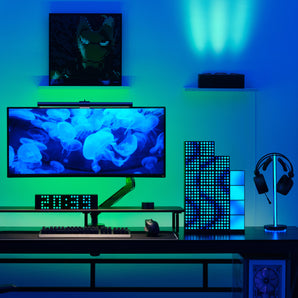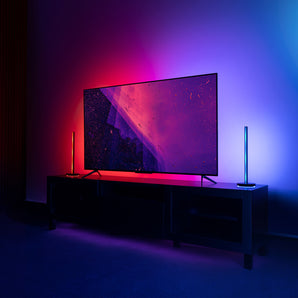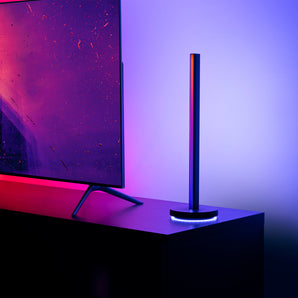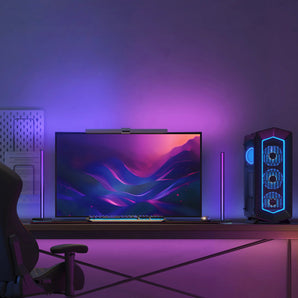A smart light bulb is a light bulb that can be controlled via an internet connection and supports smart home technology.
Users can remotely control these light bulbs through smartphone apps, voice assistants such as Amazon's Alexa, Google Assistant, or Apple's HomeKit to turn them on and off, adjust brightness, change color, adjust color temperature, and other functions, making more and more people curious about it How it works. Next, let’s explore some of the benefits and working principles of smart light bulbs.
How Do Smart Light Bulbs Work?
Smart light bulbs achieve remote control and intelligent operation functions by combining traditional lighting technology with modern wireless communication technology. Here's how smart light bulbs work:
Connectivity: Smart light bulbs have built-in wireless communication modules, such as Wi-Fi, Bluetooth, or Zigbee, allowing the light bulb to connect to your home's wireless network or pair directly with smart devices.
Control interface: Users can control the light bulb via a smartphone app, tablet, or smart home assistant such as Amazon Alexa, Google Assistant, or Apple HomeKit. These apps and devices provide an interface where users can turn lights on and off, adjust brightness, change color, and set color temperature.
Automation and customization: Smart light bulbs support preset and scheduled functions through applications, such as setting a specific time to automatically turn on and off the light or adjusting the light mode in specific situations (such as watching movies, dining, etc.). Users can also create a variety of lighting scenes based on personal preferences.
Energy management: Some smart light bulbs also provide energy monitoring functions, which can track energy usage and help users optimize power consumption and reduce energy bills.
Interoperability: Many smart light bulbs are designed to work with other smart home devices to form a complete home automation system. For example, light bulbs can be connected to security systems, sensors or other smart devices to enable smarter environmental response functions, such as automatically turning on lights when someone enters the room.
With these advanced features, smart light bulbs not only improve living comfort, but also increase the convenience and efficiency of life through energy conservation and automation.
How to Set Up Smart Light Bulbs?
Setting up smart light bulbs is a straightforward process that typically involves the following steps:
Choose the Right Bulb Type: Before getting started, ensure that you select the appropriate type of smart light bulb based on your specific requirements.
Install the Bulbs: Begin by installing the smart light bulbs into your existing light fixtures. Ensure that the power source is turned off before replacing traditional bulbs with smart alternatives to avoid any electrical mishaps.
Download the Companion App: Most smart light bulb manufacturers provide dedicated mobile apps that facilitate seamless setup and control. Download the corresponding app from the App Store or Google Play Store, depending on your device's operating system.
Connect to Wi-Fi Network: Follow the app's instructions to connect the smart bulbs to your home Wi-Fi network. This step typically involves entering your network credentials within the app interface and allowing the bulbs to establish a secure connection.
Pairing Process: Once connected to Wi-Fi, initiate the pairing process between each individual bulb and the app. This step ensures that each bulb is recognized within the app for personalized control and automation.
Customize Settings: After successfully pairing the smart light bulbs, take advantage of the app's customization features to personalize brightness levels, color temperatures, and scheduling options according to your preferences.
Voice Assistant Integration (Optional): If you use voice assistants such as Amazon Alexa or Google Assistant, consider integrating your newly installed smart light bulbs with these platforms for convenient voice-controlled operation.
Test Functionality: Verify that all settings are configured correctly by testing various functionalities such as dimming, color changes (if applicable), and scheduled on/off cycles.
By following these simple steps, you can effectively set up and configure your smart light bulbs to begin enjoying their advanced features and benefits.
What Are the Benefits of Smart Light Bulbs?

Smart light bulbs offer additional advantages over traditional lighting, improving convenience and energy efficiency in modern homes. Here are some benefits of smart lights:
Improved energy efficiency: One of the main advantages of smart light bulbs is their excellent energy efficiency. By using LED technology, these smart bulbs consume significantly less power than traditional incandescent bulbs. Using high-efficiency LED components not only reduces energy consumption but also helps reduce long-term maintenance costs for homeowners.
Customizable lighting experience: Smart light bulbs give users the flexibility to tailor their lighting experience to their preferences. Whether adjusting brightness levels, fine-tuning color temperature, or creating personalized lighting scenes for different occasions, these innovative light bulbs offer a high degree of customization to suit a variety of moods and activities.
Convenient remote control: Smart light bulbs are capable of remote control via a dedicated mobile app or smart home assistant, allowing users to conveniently access their lighting settings from anywhere.
Integration with smart home ecosystems: Another significant benefit of smart light bulbs is their seamless integration with popular smart home ecosystems such as Amazon Alexa, Google Assistant, and Apple HomeKit. This compatibility enables users to issue voice commands to control smart light bulbs, further enhancing the overall convenience and accessibility of home lighting management.
Long-lasting and durable: Smart bulbs last longer than traditional incandescent bulbs, providing durability and reliability over a longer period of time. These smart lighting solutions focus on longevity, minimizing the frequency of lamp replacements while maintaining consistent performance throughout their lifetime.
Enhanced security features: In addition to lighting, smart light bulbs also promote home security by providing features such as remote access and scheduling capabilities.
Summarize
Learn how smart light bulbs can connect to your home network and be controlled remotely via an app or voice command to dim, change color, and schedule to enhance lighting.
These bulbs connect via protocols such as Wi-Fi, Bluetooth or Zigbee to enable on/off, dimming, color changing and scheduling functions. Advanced features also include energy tracking and integration with other smart home devices for enhanced automation and energy efficiency.
Browse the Yeelight website to learn more about smart lights and products, and follow us to subscribe for more related knowledge.
FAQ
How Long Is the Service Life of Smart Light Bulbs?
The service life of smart light bulbs varies depending on factors such as usage patterns, environmental conditions, and the specific model of the bulb. On average, high-quality smart LED bulbs can last anywhere from 15,000 to 25,000 hours of operation.
This extended lifespan surpasses traditional incandescent bulbs by a significant margin, offering users long-term reliability and durability.
Will Smart Light Bulbs be Eliminated?
No, as technology continues to advance, smart lighting solutions are expected to continue to evolve with enhanced functionality and compatibility options. The growing demand for home automation and energy-efficient lighting has further strengthened the position of smart bulbs in the market.
How to Choose Smart Light Bulbs?
When selecting smart light bulbs for your home, consider the following factors:
Compatibility: Ensure that the chosen smart light bulbs are compatible with your existing smart home ecosystem or preferred control methods such as voice assistants.
Features: Assess the specific features offered by each bulb, including color-changing capabilities, dimming options, energy efficiency ratings, and automation functionalities.
Luminosity: Determine the brightness levels required for different areas within your home and select smart light bulbs that offer suitable lumen outputs based on your illumination needs.
Longevity: Prioritize models with extended service lives and reliable performance to minimize maintenance efforts over time.
Energy Efficiency: Opt for smart light bulbs that incorporate LED technology for optimal energy conservation and reduced electricity consumption.
By evaluating these considerations, you can make informed decisions when choosing smart light bulbs that align with your preferences and household requirements.
Related reading: What are monitor light bars






